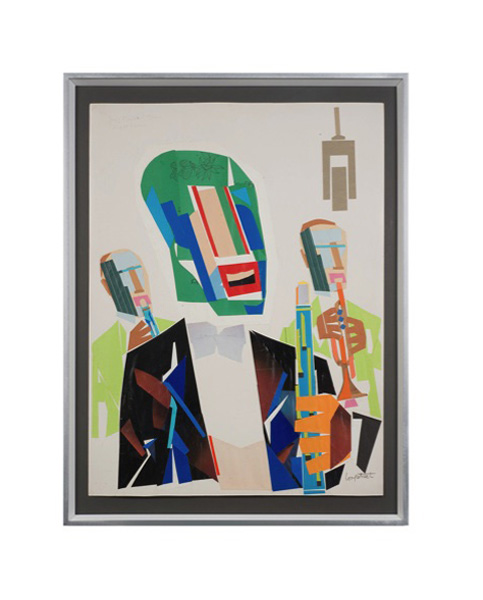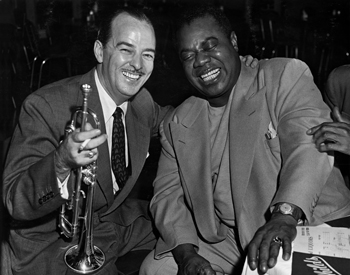Product Description
Stephen Longstreet “Jazz Festival Trio – Night Faces”, Paper cut-out, mixed media and paper collage, c. 1970’s



STEPHEN LONGSTREET (1907-2002)
“Jazz Festival Trio – Night Faces” c. 1970’s
Paper cut-out, mixed media and paper collage
Signed: Longstreet (lower right), titled in pencil (upper left)
Artist’s printed address label verso
H: 38″ x W: 28 3/8″
Stephen Longstreet was born on April 18, 1907 in New York City and attended Rutgers University (1926) and Harvard University (1927), and graduated from the New York School of Fine and Applied Art (1929); also studied in Paris with Matisse and Bonnard, as well as in Rome, London and Berlin; became painter, writer, art critic, and lecturer on art; literary critic for Reader’s Syndicate (1952-80) and for the Los Angeles Daily News; designed stage sets for RexRoth poetry jazz, 1952; president, Los Angeles Art Association. (1972-75); professor of modern writing, University of Southern California (1975-80); wrote radio plays, screenplays, and dozens of books ranging from novels to biography to travel, including: Decade, 1929-1939 (1940), The Pedlocks: A Family (1951), Gettysburg (1961), The World Revisited (1953), and The Real Jazz, Old and New (1956).
The world of jazz was a constant theme throughout Longstreet’s life.
Longstreet was introduced to ragtime and jazz by future singing legend Paul Robeson, then an All-American football player at Rutgers University. Their friendship began in 1918, when Robeson spotted the 11-year-old Longstreet sketching him as he practiced dropkicking. In his 1986 book “Storyville to Harlem: Fifty Years in the Jazz Scene,” Longstreet explained that Robeson made him “aware of the gap between the music taught on paper and the ‘razzmatazz’ sounds of the scratchy jazz recordings.” While studying at the School of Fine and Applied Arts in New York in the late ’20s, Longstreet drew the musical scenes in Greenwich Village, the speak-easies and the Cotton Club in Harlem. “I had hoped to capture with black marks on white paper, this music created by these people, and set down what they looked like, felt and did before they were gone,” he later wrote. By the late ’20s, Longstreet was furthering his artistic studies in Paris, where he met Picasso, Matisse and other artists. He also met and drew James Joyce, Gertrude Stein and the American “jazzmen” who were, he later wrote, “escaping from Judge Lynch and the back of the bus.” After returning to the United States in 1930, he traveled south to New Orleans, discovering the “strange and wonderful sounds” of jazzmen playing in Storyville, the city’s red light district, and capturing them in his work. He later drew and painted Count Basie, Sarah Vaughan, Billie Holiday, Duke Ellington and other jazz greats. Of Longstreet’s depictions of the century’s jazz scene, Louis Armstrong wrote in 1971: “You want to feel the smell–the color–the great ‘OH MY’ feeling of the jazzmen, and stomp around in the smoke and dusk of the joints … then you just go and locate some of the drawings and paintings of this cat Steve Longstreet and steal you a few.”
Over the years, Longstreet’s jazz-era works, including collages, watercolors and ink drawings, were exhibited in museums and galleries, including the National Portrait Gallery at the Smithsonian Institution. The University of Chicago Library, The Graphic Arts Collection and Department of Rare Books and Special Collections at Princeton University Library, as well as UCLA all have extensive collections of Longstreet’s artwork.
Stephen Longstreet “Jazz Festival Trio – Night Faces”, Paper cut-out, mixed media and paper collage, c. 1970’s
HANK PITCHER (b. 1949) U.S.A.
“Mr. Zogs board at Coal Oil Point” 2006
Oil on canvas, laid on board
Signed: Mr. Zogs board at Coal Oil Point (with chalk on back),
Hank pitcher 2006, Mr. Zogs Board at Coal Oil Point
For more information see: Hank Pitcher Surf, exhibit. cat. (Santa Barbara: Sullivan Goss Gallery, 2003); Surfboard Wax – A History, Jefferson “Zuma Jay” Wagner (Atglen, PA: Schiffer Publishing Ltd., 2005).
Canvas: H: 84” x W: 36”
Framed: H: 87” x W: 39”
Pitcher’s surfboard paintings are the symbol of California beach culture…strong, definite, positive and euphoric statements about life in California. The surfboard’s power as totem is seen in its power to convey identity: surfer, Californian, Hank Pitcher. All are identifiable from this symbolic representation. Hank Pitcher is the voice of California culture. At the beach, in the surf, approaching the foothills, in the mountains, on the spit of Point Conception, in the crags of Big Sur, at a beach campfire in Santa Barbara, Pitcher paints the icons of California’s culture.
Hank Pitcher’s paintings are grounded in a particular sense of place. He was born in Pasadena, California on July 20, 1949, but his family moved to Isla Vista, near Santa Barbara, when he was two years old. When they came to Isla Vista it was an outpost on the beach, and Goleta was a farm town where kids rode their horses down the avenue to buy candy at the store. He was a football star at San Marcos High School and was recruited by big-name universities. Instead of football, he chose to attend the College of Creative Studies, an alternative program within the University of California at Santa Barbara (UCSB) where he now teaches painting. He splits his time between painting and surfing, pursuing each with the commitment and energy of a linebacker.
OTTAVIANI Recanati, Italy
Covered box c. 1960
Hand wrought and repousse abstract sterling inset top with turquoise, light and dark green and cobalt blue enamel, exotic wood box.
Marks: Ottaviani (script incised signature), 925 (in an oval), Italian touchmark
H: 1 1/2″ x D: 4 1/4″ x W: 9 1/2″
Price: $2,750
